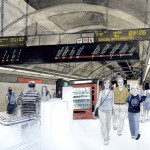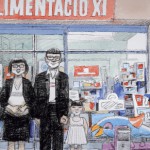
In this new dossier we invited seven authors to wander off the beaten track most typically followed by tourists and convention delegates. And we called on them to suggest alternative routes which go beyond the Gothic Quarter and Modernist Barcelona. The result is a selection of unusual routes which reveal hidden layers of the urban fabric, from Masonic Barcelona to the concealed city of passageways.

In the streets and squares of the three Barcelonas evoked by Robert Hughes, metropolitan, mediaeval and Roman, over two thousand years of history are summarised with a continuity comparable to that of European state capitals like London, Paris and Rome.

Reality is very different from what we expect. The invisible and the hidden are the origin of that to be revealed. The beginnings and the ‘raison d’être’ of Barcelona are hidden in its entrails, a place we cannot delve into, unless we keep a tight grip on Ariadna’s thread.

The private bridges are the oldest in Barcelona, but there are also among them a couple of modern and well-known ones: the false Gothic bridge in Carrer del Bisbe, and the “bridge of shame” in Carrer de les Egipcíaques. But there is no bridge dedicated to the devil.

Each Barcelona passageway is a different world, in its origin, current use, location and shape. Below we underline the uniqueness of these access routes using ten diverse examples from different districts in the city.

At the top of an imposing staircase a replica of the Statue of Liberty welcomes visitors into the Arús Public Library. This is the first stop along the route initiating us into the symbols and areas in Barcelona related to Freemasonry.

Barcelona has fewer inhabitants than Paris but a similar number of immigrants, hailing from every continent. The city and its surrounds have been very good hosts: this evolution has enriched us all.

Taking a cinema-driven route through Barcelona means establishing a dialogue between present-day reality and the cinematographic one to help understand the city.

Advertising defines our times, though its origins are quite ancient. A spooky phenomenon, advertisements often last well beyond the thing they advertise, as can be seen on many of Barcelona’s walls.

Why don’t we leave the real Barcelona to the Russian tourists and build a fake one for ourselves? In the Gràcia neighbourhood, for example, or beyond Sarrià, where there are large areas of unused land.












